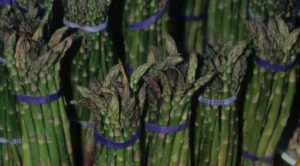Spring brings about the growth of gardens and the opening of many Farmer’s Markets in Middle America. One of the first vegetables that we typically see available in Ohio, locally grown, is asparagus. If you plan to purchase this tasty treat, look for asparagus that is nearly all green with medium size and firm stalks. Avoid pieces that are overly thin, wilted or wrin kled. Asparagus can be stored in the refrigerator for 2 to 3 days before using, and is best stored with a moist paper towel wrapped around the ends or standing in about 2 inches of water.
kled. Asparagus can be stored in the refrigerator for 2 to 3 days before using, and is best stored with a moist paper towel wrapped around the ends or standing in about 2 inches of water.
If you need to store asparagus longer than a few days, it can be frozen. To safely freeze almost all vegetables it is important to blanch them first. Blanching uses scalding water or steam to stop enzyme actions in vegetables which can cause loss of flavor, color and texture. This process also helps prevent the loss vitamins. Vegetables can be blanched by steam, boiling water, or in the microwave. For thin vegetables like asparagus, blanching just 2 to 4 minutes will help maintain high quality vegetables. Larger produce will take longer. If you have never blanched vegetables, it isn’t difficult, but the length of time is important based on the produce you are working with. To learn how, go to the National Center for Home Food Preservation site at http://go.osu.edu/blanching. After blanching asparagus it should be quickly cooled in a bath of cold water, patted dry, and stored in airtight containers.
As we well know, the antioxidants in vegetables are great to help us maintain our health. Other pluses for asparagus include being a good source of vitamin A and C; and it is fat, sodium, and cholesterol free. How do you plan to use your locally grown asparagus? Grilled, roasted, on a salad, or even pickled?

